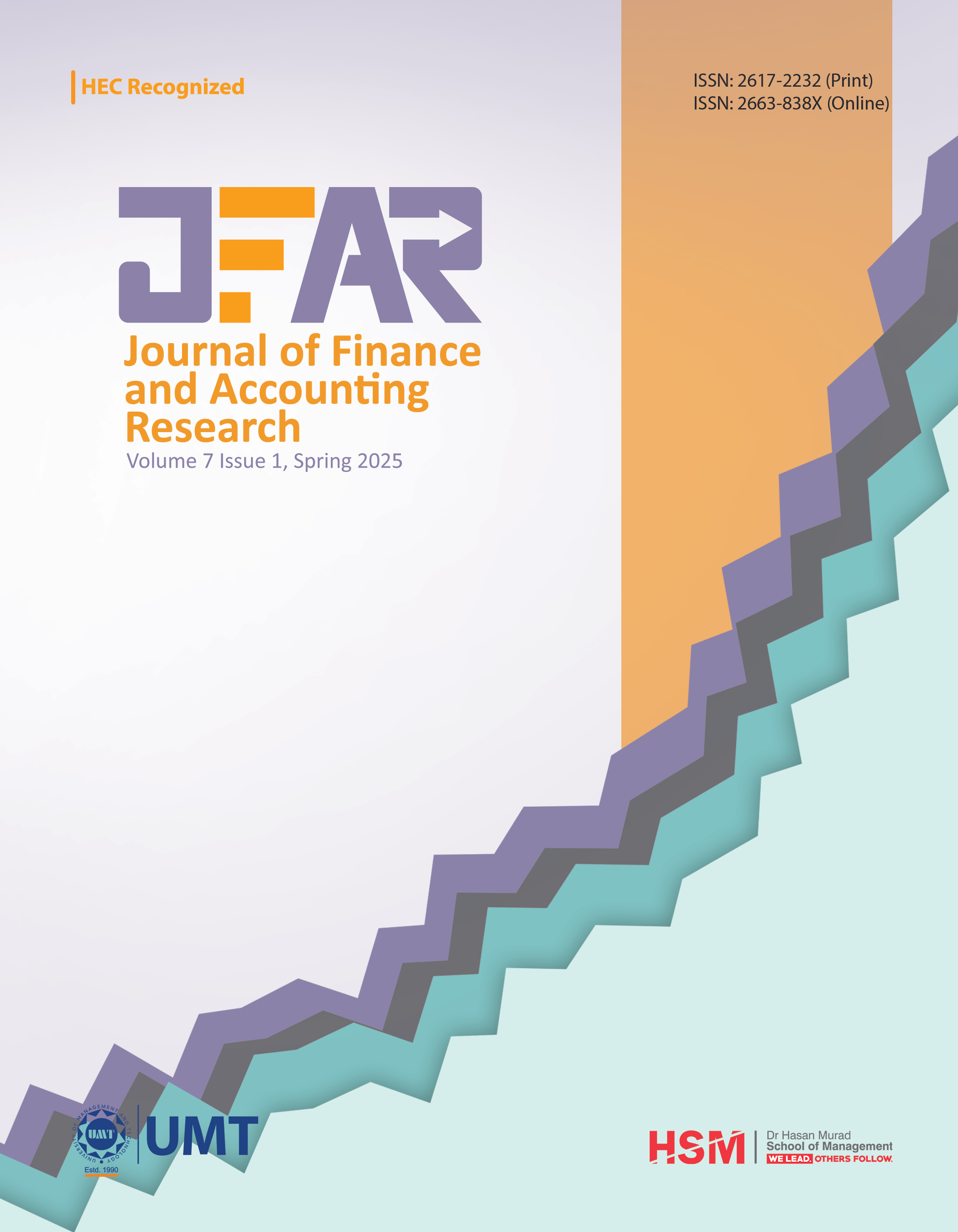Re-thinking Progress: How Financial Growth, Renewable Energy, and Innovation Shape Pakistan's Carbon Emissions
Abstract
The long-term viability of development strategies hinges on achieving a harmonious balance between economic growth and environmental protection. The current research aimed to explore the relationships of financial development (FD), renewable energy consumption (REC), and technological innovation (TI) with carbon emissions (CO2) in Pakistan. The Dynamic Ordinary Least Square (DOLS) method was employed to analyze the relevant data for the time period (1991-2023) that was derived from World Development Indicators (WDI) and World Intellectual Property Organization (WIPO). The results of Fully Modified Ordinary Least Square (FMOLS) and Canonical Correlation Regression (CCR) confirmed the robustness of the model. The results of the analysis indicated that the FD was positively related to CO2, indicating that a 1% increase in FD led to 0.10% increase in CO2 emissions (statistically significant at the 1% level). The REC had a significant positive impact on environmental quality, that is, decreasing CO2 emission by 1.44% (statistically significant at the 1% level). Whereas, the TI had a negative effect on environmental quality. A 1% increase in TI contributed to a 0.093% increase in CO₂ emissions (statistically significant at the 5% level). It was concluded that financial institutions supported industrial expansion along with increased consumption of energy-intensive goods and implementation of carbon-intensive projects. Innovations appeared to be focused on energy-intensive sectors rather than green technologies. This might be due to a dirty innovation bias, measurement issues, or delayed environmental benefits. It is recommended that the government should incentivize green energy initiatives and eco-friendly technologies to mitigate the harmful effects of environmental degradation in Pakistan. A shift towards renewable energy sources should be promoted to stabilize the environment in the long run.
Downloads
References
Ali, U., Guo, Q., Kartal, M. T., Nurgazina, Z., Khan, Z. A., & Sharif, A. (2022). The impact of renewable and non-renewable energy consumption on carbon emission intensity in China: Fresh evidence from novel dynamic ARDL simulations. Journal of Environmental Management, 320, Article e115782. https://doi.org/10.1016/j.jenvman.2022.115782
Amin, A., bte Mohamed Yusoff, N. Y., Yousaf, H., Peng, S., Işık, C., Akbar, M., & Abbas, S. (2023). The influence of renewable and non-renewable energy on carbon emissions in Pakistan: Evidence from stochastic impacts by regression on population, affluence, and technology model. Frontiers in Environmental Science, 11, Article e1182055. https://doi.org/10.3389/fenvs.2023.1182055
Anser, M. K., Usman, M., Godil, D. I., Shabbir, M. S., Sharif, A., Tabash, M. I., & Lopez, L. B. (2021). Does globalization affect the green economy and environment? The relationship between energy consumption, carbon dioxide emissions, and economic growth. Environmental Science and Pollution Research, 28(37), 51105–51118. https://doi.org/10.1007/s11356-021-14243-4
Atif, R. M., Fatima, M., Manzoor, M. Q., Javed, A., & Gull, R. H. (2024). Impact of financial development, energy consumption, trade openness, and population on CO₂ emissions in Pakistan: Application of STIRPAT model. Empirical Economic Review, 7(1), Article e71.06. https://doi.org/10.29145/eer.71.06
Awosusi, A. A., Mata, M. N., Ahmed, Z., Coelho, M. F., Altuntaş, M., Martins, J. M., & Onifade, S. T. (2022). How do renewable energy, economic growth and natural resources rent affect environmental sustainability in a globalized economy? Evidence from Colombia based on the gradual shift causality approach. Frontiers in Energy Research, 9, Article e739721. https://doi.org/10.3389/fenrg.2021.739721
Churchill, S. A., Inekwe, J., Smyth, R., & Zhang, X. (2019). R&D intensity and carbon emissions in the G7: 1870–2014. Energy Economics, 80, 30–37. https://doi.org/10.1016/j.eneco.2018.12.020
Dauda, L., Long, X., Mensah, C. N., & Salman, M. (2019). The effects of economic growth and innovation on CO₂ emissions in different regions. Environmental Science and Pollution Research, 26, 15028–15038. https://doi.org/10.1007/s11356-019-04891-y
Dickey, D. A., & Fuller, W. A. (1979). Distribution of the estimators for autoregressive time series with a unit root. Journal of the American Statistical Association, 74(366a), 427–431. https://doi.org/10.1080/01621459.1979.10482531
Djellouli, N., Abdelli, L., Elheddad, M., Ahmed, R., & Mahmood, H. (2022). The effects of non-renewable energy, renewable energy, economic growth, and foreign direct investment on the sustainability of African countries. Renewable Energy, 183, 676–686. https://doi.org/10.1016/j.renene.2021.10.066
Eckstein, D., Hutfils, M.-L., & Winges, M. (2018). Global climate risk index 2019: Who suffers most from extreme weather events. Germanwatch. https://www.germanwatch.org/en/16046
Elliott, G., Rothenberg, T. J., & Stock, J. H. (1992). Efficient tests for an autoregressive unit root. National Bureau of Economic Research. https://www.nber.org/system/files/working_papers/t0130/t0130.pdf
Fei, Q., Rasiah, R., & Shen, L. J. (2014). The clean energy-growth nexus with CO₂ emissions and technological innovation in Norway and New Zealand. Energy & Environment, 25(8), 1323–1344. https://doi.org/10.1260/0958-305X.25.8.1323
Ganda, F. (2019). The impact of innovation and technology investments on carbon emissions in selected organisation for economic co-operation and development countries. Journal of Cleaner Production, 217, 469–483. https://doi.org/10.1016/j.jclepro.2019.01.235
Gao, X., & Fan, M. (2023). The role of quality institutions and technological innovations in environmental sustainability: Panel data analysis of BRI countries. PLOS ONE, 18(6), Article e0287543. https://doi.org/10.1371/journal.pone.0287543
Government of Pakistan. (2024). Economic data repository (Easy Data). State Bank of Pakistan. https://www.sbp.org.pk/ecodata/index2.asp
Huang, W., Zheng, D., Chen, X., Shi, L., Dai, X., Chen, Y., & Jing, X. (2020). Standard thermodynamic properties for the energy grade evaluation of fossil fuels and renewable fuels. Renewable Energy, 147, 2160–2170. https://doi.org/10.1016/j.renene.2019.09.127
International Energy Agency. (2020). Energy-related CO₂ emissions, 1990–2019. https://www.iea.org/data-and-statistics/charts/energy-related-co2-emissions-1990-2019
Imran, M., Ali, S., Shahwan, Y., Zhang, J., & Al-Swiety, I. A. (2022). Analyzing the effects of renewable and nonrenewable energy usage and technological innovation on environmental sustainability: Evidence from QUAD economies. Sustainability, 14(23), Article e15552. https://doi.org/10.3390/su142315552
Jiang, C., & Ma, X. (2019). The impact of financial development on carbon emissions: A global perspective. Sustainability, 11(19), Article e5241. https://doi.org/10.3390/su11195241
Khalil, H. B., & Zaidi, S. J. H. (2014). Energy crisis and potential of solar energy in Pakistan. Renewable and Sustainable Energy Reviews, 31, 194–201. https://doi.org/10.1016/j.rser.2013.11.023
Khan, M. I., Teng, J. Z., & Khan, M. K. (2020). The impact of macroeconomic and financial development on carbon dioxide emissions in Pakistan: Evidence with a novel dynamic simulated ARDL approach. Environmental Science and Pollution Research, 27(31), 39560–39571. https://doi.org/10.1007/s11356-020-09304-z
Khan, M. K., Trinh, H. H., Khan, I. U., & Ullah, S. (2022). Sustainable economic activities, climate change, and carbon risk: An international evidence. Environment, Development and Sustainability, 24(7), 9642–9664. https://doi.org/10.1007/s10668-021-01842-x
Onofrei, M., Vatamanu, A. F., & Cigu, E. (2022). The relationship between economic growth and CO₂ emissions in EU countries: A cointegration analysis. Frontiers in Environmental Science, 10, Article e934885. https://doi.org/10.3389/fenvs.2022.934885
Park, J. Y. (1992). Canonical cointegrating regressions. Econometrica: Journal of the Econometric Society, 60(1), 119–143. https://doi.org/10.2307/2951679
Pervaiz, B., Manzoor, M. Q., Gull, R. H., & Goshi, S. (2025). Sustainable tourism development in Pakistan: Economic opportunities and environmental challenges. Pakistan Journal of Humanities and Social Sciences, 13(1), 123–133. https://doi.org/10.52131/pjhss.2025.v13i1.2642
Pesaran, M. H., & Shin, Y. (1995). An autoregressive distributed lag modelling approach to cointegration analysis. Cambridge University Press.
Pesaran, M. H., Shin, Y., & Smith, R. J. (2001). Bounds testing approaches to the analysis of level relationships. Journal of Applied Econometrics, 16(3), 289–326. https://doi.org/10.1002/jae.616
Phillips, P. C., & Perron, P. (1988). Testing for a unit root in time series regression. Biometrika, 75(2), 335–346. https://doi.org/10.1093/biomet/75.2.335
Raihan, A., Begum, R. A., Nizam, M., Said, M., & Pereira, J. J. (2022). Dynamic impacts of energy use, agricultural land expansion, and deforestation on CO₂ emissions in Malaysia. Environmental and Ecological Statistics, 29(3), 477–507. https://doi.org/10.1007/s10651-022-00532-9
Raihan, A., & Tuspekova, A. (2022). Role of economic growth, renewable energy, and technological innovation to achieve environmental sustainability in Kazakhstan. Current Research in Environmental Sustainability, 4, Article e100165. https://doi.org/10.1016/j.crsust.2022.100165
Sachs, J. D., Lafortune, G., & Fuller, G. (2024). Sustainable development report 2024: The SDGs and the UN summit of the future. Dublin University Press.
Saliba, C. B., Hassanein, F. R., Athari, S. A., Dördüncü, H., Agyekum, E. B., & Adadi, P. (2022). The dynamic impact of renewable energy and economic growth on CO₂ emissions in China: Do remittances and technological innovations matter? Sustainability, 14(21), Article e14629. https://doi.org/10.3390/su142114629
Sharif, A., Meo, M. S., Chowdhury, M. A. F., & Sohag, K. (2021). Role of solar energy in reducing ecological footprints: An empirical analysis. Journal of Cleaner Production, 292, Article e126028. https://doi.org/10.1016/j.jclepro.2021.126028
Shoaib, H. M., Rafique, M. Z., Nadeem, A. M., & Huang, S. (2020). Impact of financial development on CO₂ emissions: A comparative analysis of developing countries (D-8) and developed countries (G-8). Environmental Science and Pollution Research, 27, 12461–12475. https://doi.org/10.1007/s11356-019-06680-z
Sohag, K., Taşkın, F. D., & Malik, M. N. (2019). Green economic growth, cleaner energy and militarization: Evidence from Turkey. Resources Policy, 63, Article e101407. https://doi.org/10.1016/j.resourpol.2019.101407
Tang, C. F., & Tan, E. C. (2013). Exploring the nexus of electricity consumption, economic growth, energy prices and technology innovation in Malaysia. Applied Energy, 104, 297–305. https://doi.org/10.1016/j.apenergy.2012.10.061
Ullah, A., Dogan, M., Topcu, B. A., & Saadaoui, H. (2023). Modeling the impacts of technological innovation and financial development on environmental sustainability: New evidence from the world's top 14 financially developed countries. Energy Strategy Reviews, 50, Article e101229. https://doi.org/10.1016/j.esr.2023.101229
Villanthenkodath, M. A., & Mahalik, M. K. (2022). Does overseas eco‐friendly innovation collaboration matter for environmental quality sustainability in India? OPEC Energy Review, 46(2), 250–284. https://doi.org/10.1111/opec.12232
Wang, X., Zheng, H., Wang, Z., Shan, Y., Meng, J., Liang, X., Feng, K., & Guan, D. (2019). Kazakhstan's CO2 emissions in the post-Kyoto Protocol era: Production-and consumption-based analysis. Journal of Environmental Management, 249, Article e109393. https://doi.org/10.1016/j.jenvman.2019.109393
Wu, Y., & Wan, J. (2024). The race between global economic growth and carbon emissions: Based on a comparative study of developed and developing countries. Environmental Science and Pollution Research, 31(13), 19226–19243. https://doi.org/10.1007/s11356-024-32275-4
Zaidi, S. A. H., Danish, Hou, F., & Mirza, F. M. (2018). The role of renewable and non-renewable energy consumption in CO₂ emissions: A disaggregate analysis of Pakistan. Environmental Science and Pollution Research, 25, 31616–31629. https://doi.org/10.1007/s11356-018-3059-y
Zaman, K., & Moemen, M. (2017). Energy consumption, carbon dioxide emissions and economic development: Evaluating alternative and plausible environmental hypothesis for sustainable growth. Renewable and Sustainable Energy Reviews, 74, 1119–1130. https://doi.org/10.1016/j.rser.2017.02.072
Copyright (c) 2025 Rana Hamza Gull, Bushra Pervaiz, Muhammad Qasim Manzoor, Faisal Mehmood, Samreen Goshi

This work is licensed under a Creative Commons Attribution 4.0 International License.
JFAR follows an open-access publishing policy and full text of all articles is available free, immediately upon acceptance. Articles are published and distributed under the terms of the Creative Commons Attribution 4.0 International License. Thus, work submitted to UMT Journals implies that it is original, unpublished work of the authors; neither published previously nor accepted/under consideration for publication elsewhere. On acceptance of a manuscript for publication, a corresponding author on the behalf of all co-authors of the manuscript will sign and submit a completed Author Consent, Copyright, and Declaration Form.







